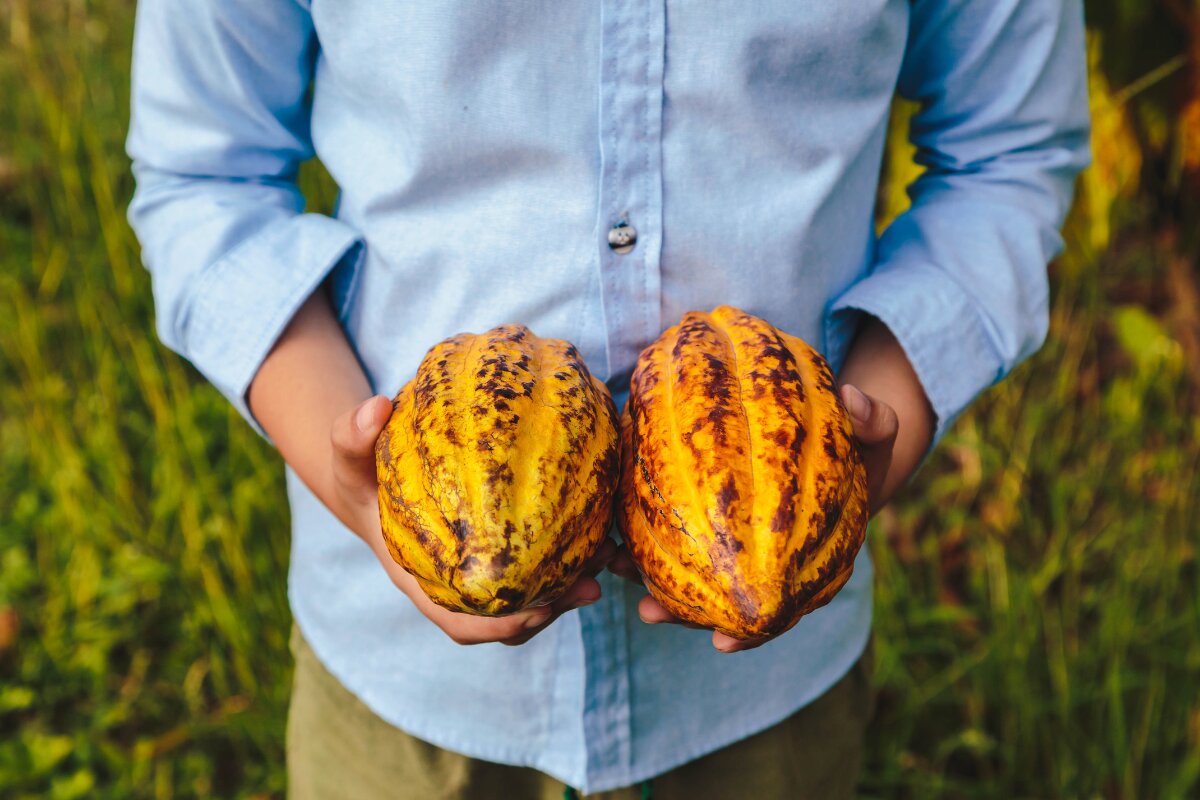Did you know that global cacao farmers produce around five million tons of cacao beans per year? And the main cacao-producing countries are the Ivory Coast and Ghana, which account for more than half of the world’s cacao production. Or that more than a third of cacao beans are processed in Europe? Incredible information about chocolate, right? Read on to learn all about the production of chocolate around the world.
Chocolate origin
Cacao is native to Mesoamerica. The term “cacao” is derived from Nahuatl, the language of the Aztecs and Mayans. Many people believe that cacao was first grown in the Amazon and upper Orinoco basins, but the Mayans were first to develop techniques to cultivate it successfully by around 300 BC. Cacao beans were considered a symbol of wealth for these civilizations and were used as a form of currency.

Chocolate production
Chocolate is made from the fermented and dried beans of the cacao tree, Theobroma Cacao. The tree is native to the tropical rainforests of South and Central America. Today, cacao is grown in a narrow belt 20 degrees north and south of the equator line in Africa, Asia, Latin America, and Oceania.
Cacao harvesting is hard manual work and very labor-intensive since every cacao pod has to be harvested by hand. Cacao Trees are also very sensitive to environmental conditions, so caring for them and collecting the fruit requires a lot of attention. The cocoa tree blooms and bears fruit throughout the year.Each cacao pod contains around 30 to 50 seeds which are coated in a white pulp – these seeds are the actual cacao beans (but they aren’t really “beans”). In full production, one tree can produce about 50-100 pods which is enough to make a few kilos of dried cocoa beans. Unlike many common fruits, cacao pods do not all ripen at the same time, therefore the trees must be checked frequently.
Cacao is also a very delicate crop, it can be easily affected by climate changes and it is susceptible to diseases and pests. After harvest, the ripe pods are cut open and the seeds are removed to begin the fermentation process. After a week of fermentation, the cocoa beans are spread out in the sun to dry. After this critical flavor-development process, the cocoa beans are ready to be sold to chocolatiers, who then transform them into chocolate.
Types of cocoa beans
The cocoa bean market distinguishes between bulk and fine-flavor beans. Bulk cocoa beans are mainly produced from the Forastero variety in West Africa, Brazil, and also Asia. The Forastero variety is more resistant to diseases than Criollo and Trinitario varieties which generate highly aromatic fine flavor cacao with low acid levels.
Most cacao is produced in West Africa
About 70 percent of the world’s cocoa beans come from four West African countries: Ivory Coast, Ghana, Nigeria, and Cameroon. The Ivory Coast and Ghana are the two biggest producers of cacao, accounting for more than 50 percent of the world’s cocoa beans. Worldwide, 90% of cocoa is grown on small family farms of 2 to 5 hectares (5-12 acres), while just 5% comes from large plantations of 40 hectares (~100 acres) or more. Cacao production provides livelihoods to between 40 and 50 million farmers, rural workers, and their families. In the Ivory Coast and Ghana, up to 90% of the farmers rely on cacao as their primary income source.
From 2019 to 2021, Ivory Coast alone produced approximately 2.1 million metric tons of cocoa beans annually. In the 2021-2022 cacao season, around 4.9 million tons of cacao were produced worldwide. Ivory Coast and Ghana were by far the two largest cacao-growing countries, accounting for over 60% of global cacao production, followed by Ecuador at 7%. In Asia, Indonesia is the largest producer country.

Europe is the leading processor of cocoa beans
Cocoa beans are processed into cocoa mass, cocoa butter, cocoa powder, and other cocoa products around the globe. One-third of the annual cocoa produced is ground in Europe. 628,000 tons – or 12% of the beans – are ground in the Netherlands alone. Switzerland processes around 53,000 tons of cacao, which corresponds to about one percent of the global cacao production. With an annual consumption of 25 lbs (11.6kg) of chocolate per person, Switzerland led the international statistics in 2021. On average, a person in Switzerland consumes approx ten times more chocolate per year than a person in India.
Cacao production has risen over the past 40 years, with up to 95% of cocoa beans traded on international commodity markets. The cocoa market is volatile and subject to various trends. The ups and downs are caused by political uncertainties, weather-related events, production shortfalls, and overproduction in producing countries.
Countries that produce the most chocolate

The countries that produce most of the world’s chocolate are Germany, Belgium, Italy, Switzerland, and The United States. These countries also account for over 60% of the world’s total chocolate exports.
3 chocolate production facts
- Cocoa production is increasingly threatened by climate change
- Most cacao farming families live in poverty
- More than a third of cacao beans are processed in Europe.
We have provided an overview of the entire cacao production from start to finish, from its origins to its processing around the globe. It is important for us consumers to realize where our chocolate comes from so we can appreciate and respect it. So, next time you reach for a piece of chocolate, take a moment and think about where it came from and what it took to get into your hands!








